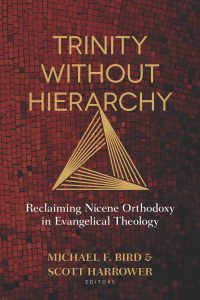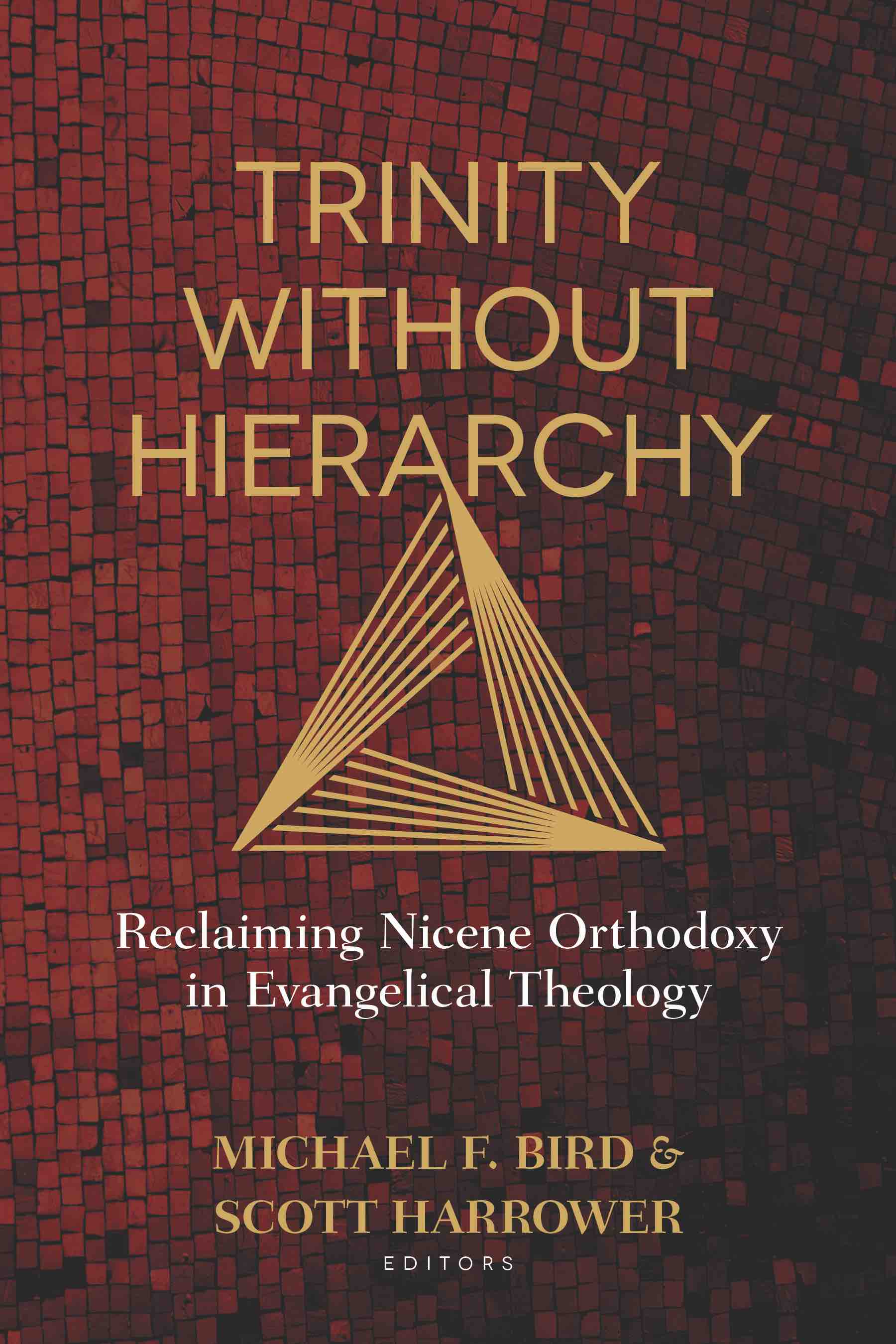Bird, Michael F., and Scott Harrower, eds. Trinity without Hierarchy: Reclaiming Nicene Orthodoxy in Evangelical Theology. Grand Rapids: Kregel, 2019, pp. 344 $25.99, paperback.
The sixteen essays of Trinity without Hierarchy (subsequently, TwH) together argue that conceptualizing the Trinity in terms of eternal relations of authority and submission (hereafter, ERAS) conflicts with the “the apostolic and evangelical faith” (p. 21). TwH’s editors Michael F. Bird and Scott Harrower lecture at Ridley College in Melbourne. Bird has defended ERAS previously, but he now argues that this approach (popularized by Wayne Grudem and Bruce Ware) is “analogical to a semi-Arian subordinationism” (pp. 9-12, 10). Harrower published Trinitarian Self and Salvation in 2012 and God of All Comfort (2019), both exploring Trinitarian theology. TwH largely responds to the 2015 monograph edited by Ware and John Starke, One God in Three Persons. TwH presents ERAS as implicitly subordinating the Son’s glory in teaching that he eternally submits and that this grounds creational hierarchies (pp. 10-11). TwH provides biblical, historical, and systematic analysis to counter ERAS’s hermeneutics and theological conclusions.
According to TwH, ERAS errantly interprets Scripture’s Trinitarian economy. Amy Peeler (pp. 57-83) exemplifies the book’s hermeneutical case with her biblically focused argument: “Hebrews does not demand [the ERAS] interpretation” (p. 68). Both John Owen, according to T. Robert Baylor’s historical argument (pp. 165-93), and the entire Reformed tradition, in Jeff Fisher’s historical analysis (195-215), understood Trinitarian subordination to be history-dependent. Harrower provides analysis from systematics in “Bruce Ware’s Trinitarian Theology” (pp. 307-30), presenting Ware as selectively choosing when to connect the economic and immanent Trinity.
TwH makes the case that an immanent-based submission structure conflicts with God’s self-existence (p. 283). From a historical perspective, Amy Brown Hughes (pp. 123-39) appeals to Gregory of Nyssa in describing God’s otherness as the barrier between subordination and self-existence. Jules A. Martinez-Olivieri (pp. 217-39) makes a case from systematics that if Christ’s obedience is relationally proper, then creation becomes “a necessary reality for God and the life of the Son” (p. 231). Self-existence dooms Trinity-society analogies (p. 235).
TwH also argues that ERAS contradicts divine simplicity. Peter J. Leithart’s historical analysis of Athanasius (pp. 109-22) agrees with Madison N. Pierce’s 1 Corinthians-based statement (pp. 39-55): the persons’ interdependent unity “disallows subordination within the Godhead” (p. 53). Tyler R. Wittman (pp. 141-64; 151-53) demonstrates historically that, though Aquinas called the Father the Son’s authority, Aquinas denied intra-Trinitarian commanding. In Stephen R. Holmes’s systematic-based argument (pp. 259-73), he explains, “Authority and submission require a diversity of volitional faculties” (pp. 270-71). According to James R. Gordon (pp. 289-306), non-procession distinctions undermine the Son’s essence.
In critique, here are three positives and three correctives. (1) Positively, TwH’s organizing principle commends itself: first Bible, then history, then systematics. This principle rightly begins with Scripture. Historical theology then precedes systematics with the goal of accounting for the Spirit’s historical working. This theological method is worthy of imitation.
(2) Also, TwH keeps the dialogical movement toward consensus alive in Trinitarian dogmatics. TwH provides ERAS scholars opportunity either to be persuaded or to respond with greater precision. Assuming both sides are sincere—which charity requires—maximal specification should serve to draw towards the truth.
(3) TwH clarifies doctrinal overlap between the two sides. In Peeler’s article, she states, “Thus far . . . I believe I have articulated theological positions with which few would disagree. God the Father and God the Son share glory and power and will because both are God, yet the author [of Hebrews] also can describe them as distinct persons who perform distinct actions in the economy of salvation” (p. 66). Both sides seek Scripture’s authoritative backing. Both understand the Trinitarian mission to reveal eternal Trinitarian reality. Both seek to affirm the pro-Nicene tradition: God self-exists as simple essence and subsists in three real, distinct, indwelling persons. Both affirm an eternal Trinitarian order—from Father through Son to Spirit. TwH’s acknowledgement of this consensus is helpful.
TwH runs into difficulties. First, it does not sufficiently support its case that ERAS makes unbiblical economic-immanent conclusions. TwH’s arguments against ERAS’s hermeneutics do not address ERAS arguments adequately. For example, when Harrower represents Ware’s hermeneutics as arbitrarily selective (pp. 322-24), he overlooks at least one principle-based explanation. ERAS scholars—like authors of TwH—move analogically from Trinitarian mission to eternal relations. The difference lies in how both sides distinguish economic necessities and contingencies based on scholars’ conflicting presuppositions.
Second, the arguments against ERAS from self-existence and simplicity assume their conclusions. Authors in TwH repeatedly state as obvious that ERAS necessitates creation and divides the Trinity. Maybe no version of ERAS is compatible with self-existence and simplicity; however, this needs to be shown. On a pro-Nicene account, the Son immanently subsists, eternally begotten in the Father’s communication of essence (pp. 203-5). The Son’s will is the Father’s but also from the Father. Athanasius (Against the Heathens, 46.6; Discourses against the Arians, 2.31) and Augustine (On the Trinity, 2.1.3; 2.5.9) understood this immanent relational structure to be a creation-independent archetypal basis for the economic sending-structure. It is less than obvious that this relational structure means God needs creation.
TwH authors also assume their conclusions in denying distinctions in a simple will. According to a pro-Nicene theology of simplicity, indwelling persons can distinctly subsist as asymmetric relations in a simple essence. Leithart suggests distinctions within attributes: “Perhaps the attributes are ‘inflected’ personally, such that the Father’s power and wisdom is paternal power and wisdom, the Son’s filial, the Spirit’s spiritual. . . . It seems like something like this is necessary if we want to avoid slippage into modalism” (p. 115, n. 12). ERAS proponents have consistently defended ERAS in a similar way. Since ERAS identifies proper notions entailed by the personal, relational distinctions—internal to the essence and will—arguments that ERAS divides the essence also fall flat.
Third, TwH is weighed down by unhelpful “boogey-man” associations. Bird begins by stating that ERAS is “quasi-homoian” (p. 10; i.e. comparable to a type of semi-Arianism). Adesola Akala (pp. 23-37) and Ian Paul (pp. 85-107) excellently rebut Arian interpretations of John’s Gospel and Revelation, respectively (without acknowledging that ERAS also rejects Arian conclusions). Leithart argues against a kind of monarchical, polytheistic social trinitarianism (pp. 110, 115, 121). Martinez-Olivieri groups ERAS in with liberal theology since both have grounded social ethics on Trinitarian relations (pp. 234-35). Holmes argues that ERAS proponents are as different from classical Trinitarians as Unitarians and Jehovah’s Witnesses (p. 271). Most chapters do not make such associations, but Cole alone states that ERAS “falls within the bounds of Christian faithfulness” (p. 281). While nuanced comparisons with erroneous positions can illuminate, these “bad guy” groupings, at their best, muddy the water and, at their worst, uncharitably slander.
TwH clarifies its similarities with and differences from ERAS. The book gives nuanced Trinitarian doctrine proper focus. The book will primarily serve scholars and PhD students but may also serve master’s-level classes in which terms can be clarified and contrasting books/arguments can be discussed. However, students will require ample awareness of classical Trinitarian categories such as essence-persons, attributes-properties, economic-immanent relations, mission-processions, and indivisible-divisible/external-internal operations. TwH will help the student recognize that ERAS holds to a stronger economic-immanence connection while TwH understands the persons to “disappear” into the essence (p. 297). The student should look for the authors’ grounds for maintaining that the Son’s incarnation is not based in the Son’s identity as Son. The student should also search for why the authors accept an eternal Trinitarian ordering but deny that it necessitates a proper authority-submission economy.
Kyle W. Bagwell
The Southern Baptist Theological Seminary





